Optimization of arc current pi regulator parameters by sofrware modeling
DOI:
https://doi.org/10.15588/1607-6761-2025-2-1Keywords:
control system, robust system, regulator settings, plasma arc, optimization, computer model, PI regulator, determination of regulator parametersAbstract
Purpose. To create a computer model of a converter operating on a plasma arc and to determine the optimal values of the coefficients of the PI current controller, ensuring optimal switching between its operating modes and high quality of control processes. In doing so, use the MATLAB / Simulink software.
Methodology. Computer simulation method, separation method – optimal filtering and optimal deterministic control and methods for adjusting regulators.
Findings. A multilevel model was formed, the values of the PI current regulator tuning parameters were determined, at which the DC-DC converter observes optimal switching between its operating modes and high quality of control processes. Analytical methods for determining the PI regulator parameters do not allow obtaining optimal settings, since they are based on highly simplified models, but their use is necessary to obtain preliminary settings, without which accurate tuning can take a long time. It was established that the optimal regulator provides optimal resistance to disturbances at the input and output of the object and compensates for changes in parameters in a similar way. The system has a satisfactory transient process under non-zero initial conditions in response to a given reference influence and to a change in the set point, has good stability characteristics and is not very sensitive to disturbances and changes in the parameters of the object.
Originality. An approach to determining a continuous linear model of a power converter of electrical energy is proposed and the optimal choice of parameters for setting the regulator of its control system is given, which form the basis for constructing any plasma torch power supply system, which ensures the specified accuracy of regulation and speed of operation.
Practical value. The proposed principle of solving the problem of determining the coefficients of PI regulators can be applied to various dynamic objects, the description of which is permissible using linear and differential equations. The results presented in the work can be used for the design of pulsed power supplies for electrical technologies.
References
B&R Industrie-Elektronik GmbH. https://pdf.directindustry.com/pdf/b-r-industrie-elektronik/innovation.
Åström K.J., Hägglund T. (2006) Advanced PID Control. ISA – The Instrumentation, Systems, and Automation Society, 460.
Richard C. Dorf, Robert H. Bishop. (2022). Modern Control Systems. Pearson Education Limited, 1024.
Beginner's search https://depatisnet.dpma.de/DepatisNet/depatisnet?action=einsteiger (access 26.06.2024)
Je.M. Vereshhago, V.I. Kostjuchenko, S.M. Novogrec'-kyj. (2023). Analiz peretvorjuvacha postijnogo strumu, shho pracjuje na plazmovu dugu. // Electrical engineering and electromechanics, 5, 31–36. https://doi.org/10.20998/2074-272X.2023.5.05
E. Vereshchago, V. Kostiuchenko, Y. Stohniienko. (2023). Synthesis of a Control System of a Pulse Converter for Plasmatron Power Supply. IEEE 4th KhPI Week on Advanced Technology (KhPIWeek). 394-397. https://doi.org/10.1109/KhPIWeek61412.2023.10312905
Åström K.J., Murray R.M. (2008). Feedback Systems: an Introduction for Scientists and engineers. New Jersey: Princeton University press.
Zigler J.G. and Nichols N.B. (1942) Optimum settings for Automatic Controllers. Trans. ASME. 64. 759-768.
O’Dwyer. (2009). Handbook of PI and PID controller tuning rules. Ireland: Imperial College Press. – 3rd edition. 623.
Åströn K.J., T. Hägglund. (2000). Benchmark Systems for PID Control. International Federation of Automatic Control. 165–166.
Ju.O. Romasevych, V.S. Lovejkin, A.P. Ljashko, O.G. Shevchuk, V.V. Makarec'. (2021). Rozroblennja optymal'nyh avtomatychnyh reguljatoriv. Monografija. K.: CP „KOMPRINT”, 250.
Romasevych Yu., Loveikin V., Usenko S. (2019). PI-controller tuning optimization via PSO-based technique. PRZEGLĄD ELEKTROTECHNICZNY. R. 95 NR 7. 33–37.
Ya-Gang Wang. Hui-He Shao. (1999). Automatic tuning of optimal PI controllers. Decision and Control. Proceedings of the 38th IEEE Conference. 4. 3802 – 3803. DOI: 10.1109/CDC.1999.827947
Egorov V.A., Egorova J.G. (2021). The typical settings for automatic control systems. Lecture Notes in Net-works and Systems. 200. 177–186. DOI: 10.1007/978-3-030-69421-0_19
Je.M. Vereshhago, V.I. Kostjuchenko, Je.V. Stognijenko, A.Ju. Grjeshnov. (2024). Keruvannja dynamikoju impul'snogo peretvorjuvacha z m’jakym peremykannjam, shho pracjuje na dugove navantazhennja. Technical electrodynamics. 6. 21 – 30. https://doi.org/10.15407/techned2024.06.021
D'jakonov V.P. (2012). MATLAB. Polnyj samouchitel'. Moscow: DMK Press, 768. (in Russian.)
Downloads
Published
How to Cite
Issue
Section
License
Copyright (c) 2025 V.I. Kostiuchenko, Y.M. Vereshchago, M.V. Dzhanhyrov, A.P. Yeremenko, Y.V. Stohniienko

This work is licensed under a Creative Commons Attribution-ShareAlike 4.0 International License.
Creative Commons Licensing Notifications in the Copyright Notices
Authors who publish with this journal agree to the following terms:
Authors retain copyright and grant the journal right of first publication with the work simultaneously licensed under aCreative Commons Attribution License that allows others to share the work with an acknowledgement of the work's authorship and initial publication in this journal.
Authors are able to enter into separate, additional contractual arrangements for the non-exclusive distribution of the journal's published version of the work (e.g., post it to an institutional repository or publish it in a book), with an acknowledgement of its initial publication in this journal.
Authors are permitted and encouraged to post their work online (e.g., in institutional repositories or on their website) prior to and during the submission process, as it can lead to productive exchanges, as well as earlier and greater citation of published work.

